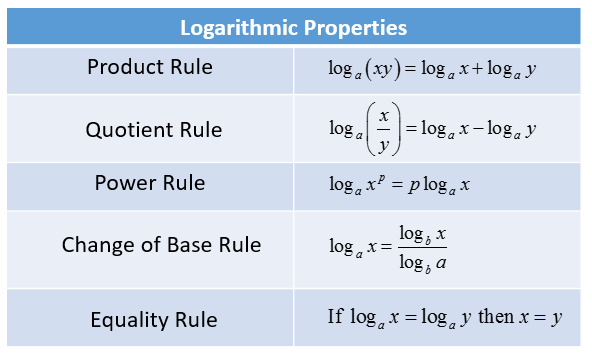Logarithmic Properties and Functions
Summary
This module introduces logarithmic functions and properties helpful in solving problems involving exponents and/or logarithms.
Logarithms and Exponents
Logarithmic functions are the inverse of exponential functions. Any exponential functions can be rewritten in logarithmic form. All logarithmic functions can also be expressed in exponential form.
An exponent tells us how many times to multiply a number. For example:
23 = 2 x 2 x 2 = 8
A logarithm helps us solve for an unknown exponent.
If we are given the problem:
2x = 8
Then we can solve by converting it to a logarithmic form:
log2(8) = x
In this case, x = 3, because 23 = 8.
So, the general method for converting between exponential and logarithmic is as follows, where a is the base and x is the exponent:

Conversion from exponential to logarithmic form
A couple of important things to note about the base (a) in logarithmic functions:
- a must be a positive number
- a cannot be equal to 1
Logarithms are very useful for solving problems with very large numbers while working with numbers of a more manageable size.
Properties
While some logarithmic problems can be easily solved in your head (such as log2(8) = x, where we know x = 3) or on a calculator (such as log base 10 problems known as 'common log' problems, because the log button on your calculator uses a base of 10, or log base e which can be solved using the ln button).
However, other problems require more manipulation to be solved. The following rules are very helpful in working with problems involving logarithms:

Useful properties for solving logarithmic equations
Examples
Product Rule
The product rule says that multiplication inside the logarithm can be converted to addition outside the logarithm.
For example:
log2(128) = x
Since 128 = 8 x 16, this problem can be rewritten this way:
log2(8*16) = log2(8) + log2(16) = x
If we remember that log2(8) = 3 and log2(16) = 4, then we can solve log2(128) = 3 + 4 = 7
Quotient Rule
The quotient rule says that division inside the logarithm can be converted to subtraction outside the logarithm.
For example:
log3(243/9) = x
Can be rewritten as:
log3(243/9) = log3(243) - log3(9) = x
If we know that 243 is 3 to the 5th power and 9 is 3 squared, then we know that log3(243) = 5 and log3(9) = 2, so:
log3(243/9) = log3(243) - log3(9) = 5 - 2 = 3
Power Rule
The power rule says that an exponent inside a logarithm can be moved in front of the logarithm.
For example:
log2(8)3 = x
Can be rewritten as:
log2(8)3 = 3log2(8)
Since we already know that log2(8) = 3, this problem becomes:
log2(8)3 = 3log2(8) = 3(3) = 9
Change of Base Rule
The change of base rule allows you to convert the logarithmic equation to a different base. This is very useful when you want to convert to a base that can be completed using your calculator or one that you can calculate logically in your head.
For example:
log7(100) = x
Remember that log10 can just be written as log. So, this equation can be rewritten:
log7(100) = log100/log7
We know that log100 = 2, because 100 is 102
We can use a calculator to find that log7 = 0.845 using rounding
So:
log7(100) = log100/log7 = 2/0.845 = 2.367 (using rounding)
Equality Rule
The equality rule says that if you have two logarithms with the same base that are equivalent, then what is inside the logarithms are equivalent to each other.
For example:
log5(3x-4) = log5(5x+2)
Because both sides of the equation have the same base, we can simply remove the log5 from both sides and rewrite the equation like this:
3x - 4 = 5x + 2
Now, we can continue solving using simple algebra:
Subtract 3x from both sides:
-4 = 2x + 2
Subtract 2 from both sides:
-6 = 2x
Divide both sides by 2:
x = -3
Conclusion
I hope you can see how logarithms can be used to solve exponential equations and how using the property rules of logarithms can make this process much simpler.